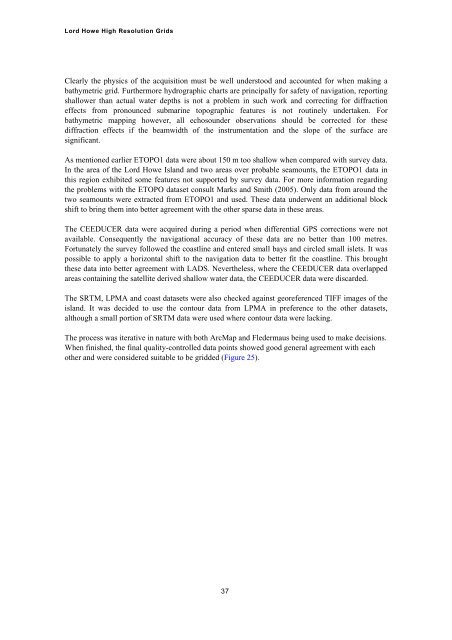Document Title - Geoscience Australia
Document Title - Geoscience Australia
Document Title - Geoscience Australia
Create successful ePaper yourself
Turn your PDF publications into a flip-book with our unique Google optimized e-Paper software.
Lord Howe High Resolution Grids<br />
Clearly the physics of the acquisition must be well understood and accounted for when making a<br />
bathymetric grid. Furthermore hydrographic charts are principally for safety of navigation, reporting<br />
shallower than actual water depths is not a problem in such work and correcting for diffraction<br />
effects from pronounced submarine topographic features is not routinely undertaken. For<br />
bathymetric mapping however, all echosounder observations should be corrected for these<br />
diffraction effects if the beamwidth of the instrumentation and the slope of the surface are<br />
significant.<br />
As mentioned earlier ETOPO1 data were about 150 m too shallow when compared with survey data.<br />
In the area of the Lord Howe Island and two areas over probable seamounts, the ETOPO1 data in<br />
this region exhibited some features not supported by survey data. For more information regarding<br />
the problems with the ETOPO dataset consult Marks and Smith (2005). Only data from around the<br />
two seamounts were extracted from ETOPO1 and used. These data underwent an additional block<br />
shift to bring them into better agreement with the other sparse data in these areas.<br />
The CEEDUCER data were acquired during a period when differential GPS corrections were not<br />
available. Consequently the navigational accuracy of these data are no better than 100 metres.<br />
Fortunately the survey followed the coastline and entered small bays and circled small islets. It was<br />
possible to apply a horizontal shift to the navigation data to better fit the coastline. This brought<br />
these data into better agreement with LADS. Nevertheless, where the CEEDUCER data overlapped<br />
areas containing the satellite derived shallow water data, the CEEDUCER data were discarded.<br />
The SRTM, LPMA and coast datasets were also checked against georeferenced TIFF images of the<br />
island. It was decided to use the contour data from LPMA in preference to the other datasets,<br />
although a small portion of SRTM data were used where contour data were lacking.<br />
The process was iterative in nature with both ArcMap and Fledermaus being used to make decisions.<br />
When finished, the final quality-controlled data points showed good general agreement with each<br />
other and were considered suitable to be gridded (Figure 25).<br />
37

















